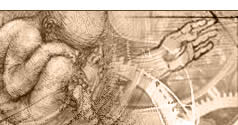 |
 |
 |
 |
 |
 |
 |
 |
|
 |
 |
 |
46 Uranium and polonium radiohalos
|
| Menu | back |
The frequency of uranium and polonium radiohalos in granite from the Palaeozoic and Mesozoic periods, allegedly 251 to 542 million years ago, indicates one or more phases of temporarily accelerated radioactive decay. Therefore, the results of radiometric measuring methods, including the fission track method, can be explained very well using the model of a young Earth.
|
 |
|
Among other substances, granite contains biotite or black mica which contains a very small quantity of uranium. If this uranium is concentrated at spots, the decay of the uranium can form microscopically visible radiohalos (1).
Uranium and polonium radiohalos |
Larry Vardiman and his team studied three groups of granite specimens (2):
- One from the Precambrian era (allegedly 542 million to 4.5 billion years ago)
- One from the Palaeozoic-Mesozoic period (allegedly 251 to 542 million years ago)
- One from the Cenozoic period (allegedly up to 250 million years ago)
It was noted that the frequency of radiohalos in the Palaeozoic era was occasionally significantly higher than in the other formations. This means that during this period, accelerated radioactive decay occurred with high probability. This breach of the rule makes a uniform interpretation of the development of these geological formations impossible. Why are significantly fewer radiohalos present in the upper and lower strata than in the middle strata? Especially in the allegedly four billion years long Precambrian period, significantly more radiohalos could be expected than in the Palaeozoic/Mesozoic period which lasted only a few hundred million years.
Results of fission track method:
So-called fission tracks result in zirconium crystals during radioactive decay of uranium. In this process, a number of atoms are knocked out of the normal crystal lattice leaving tiny tracks. After treatment with a suitable etching media, these tracks can be enlarged to make them visible under a microscope. The age of the crystal can then be calculated from the number of tracks and the heavy atoms that have not yet decayed.
The most frequent material to produce fission tracks is uranium 238. If it splits, it forms palladium 119 producing a fission track which can be observed in transparent material as well as in natural glass. When the specimen is temporarily heated by fifty to four hundred degrees, the tracks vanish. This means that all specimens containing fission tracks provide information of their thermal history. Determination of the age using the fission track method does not indicate the age of the rock, but primarily the time since the specimen was last heated to a significant extent.
The fission tracks can be counted after cleaning and etching the specimen. Then, the number of uranium 238 atoms which have not yet decayed are counted using a suitable measuring method. Conventional evaluation of the measured results, render an Earth history extending over millions and billions of years. However, if we consider the temporarily accelerated decay indicated by the uranium and polonium radiohalos, the results of the fission track method coincide quite well with the model of a young Earth (3).
These 47 | Menu |
back
|
References:
|
| (1) |
Robert V. Gentry, Creation´s Tiny Mystery, Earth Science Associates, May 1992, page 214. |
| (2) |
Larry Vardiman, Andrew A. Snelling, Eugene F. Chaffin, Radioisotopes and the age of the Earth 2, Institute for Creation Research, El Cajon, CA, 2005, pages 101-207. |
| (3) |
Don DeYoung, Thousands
not Billions, Challenging an Icon of Evolution, Master Books, 2005. | |
| |
| (Image) Screenshot from video "Fingerprints of Creation" by Dr. Robert Gentry. See http://www.0095.info/en/index_links.html |
| |
Comment this Site!
|
 |
 |
 |
 |
|

